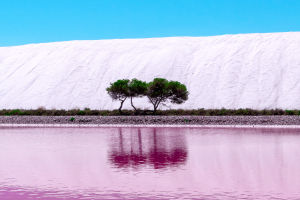Speaking of salt Lake, many people may still be relatively unfamiliar. Here's what you didn't know about salt lake. Generally speaking, a salt lake is a lake with a high salt content that enters the late stage of the evolution and development of lakes. Usually, we call a salt lake if the water is more than 3.5% salt.
Because of arid or semi-arid climate conditions, lakes tend to evaporate more than they can recharge, which shrinks the water and leads to higher concentrations of salt. When the water is reduced to the point where the salt in the water exceeds its solubility, it results in the precipitation of salt, resulting in the formation of sedimentary deposits of various salts on the lakefront and bottom.
In addition, there are closed terrains that allow runoff from the catchment to flow toward the lake. In this way, the lake won't leak out, and it can be replenished with salt through runoff. The lake is replenished with salt and evaporates water at the same time, creating a salt lake.
As many as 200 kinds of salt minerals are deposited in the lake, and many of them are essential for human life. Up to now, human beings have been able to extract a large number of stone salt, alkali, Glauber, potassium, lithium, magnesium, and other basic raw materials which can be used in the chemical industry, agriculture, light industry, and other industries from the salt lake.
This has also played an important role in promoting the development of human industry and production.
In the Salt Lake Scenic Area, many tourists will collect pure natural salt grains in the lake, ready to take home to eat. First of all, it is necessary to correct it. Although this salt is not a dangerous item in the chemical sense, it is not recommended to eat it.
The salt we eat in daily life is made through complex chemical processes, which can ensure safety. However, salt in salt lakes will inevitably have a lot of impurities, so it is best not to eat it.
Salar de Uyuni
Salar de Uyuni is about 250 kilometers long from east to west and 100 kilometers wide from north to south, covering an area of 10,582 square kilometers. Salar de Uyuni is the world's largest salt-covered wasteland, rich in rock salt and gypsum. Locals often build small salt mounds of about 1 meter to dry it out.
It is only during the rainy season from December to April each year that the salt marsh turns into a salt lake and presents a stunning view. It's the dry season for the rest of the year. Especially after the rain, the lake will be like a mirror, reflecting the reflection of the sky, giving people a kind of suffocating beauty.
Utah, Big Salt Lake
Big Salt Lake, Utah, is the largest inland salt lake in North America and the largest saltwater lake in the Western Hemisphere. It is the area with the highest salt in the world after the Dead Sea. It is called the "Dead Sea of the United States". The salt content of the lake here is as high as 25 % of the salt content, and the buoyancy is very strong.
Big Salt Lake is located in the basin western United States and is surrounded by mountains and snow. The supplement of the lake mainly comes from melting snow. After thousands of years of the natural ecological cycle, the mineral content in the salt lake is getting higher and higher, and the concentration of the lake is 50 times higher than the seawater.
Lop Nur Salt Lake
Lop Nur Salt Lake is known as the "Sea of death". Lop Nur has one of the largest dry salt lakes in the world -- Lop Nur Salt Lake. It's made up of several small salt lakes, like pearls scattered in the desert.
Most of the lake here is green and transparent, the shore of the lake formed by different salt precipitated into a white salt belt. From a distance, it looks like an emerald with a silver border.


